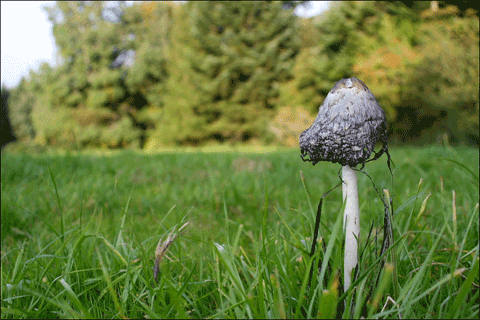Key words :
future energies,
,
bunker spawn
,econol
,oil spill
,opisthokonta
,insecticide
,mycélium
,antiviral
,ethanol
,fungi
Can Mushrooms Save the World?
30 Jul, 2009 07:08 pm
Mycelium may offer a natural source of insecticides, antivirals, biological filters, ethanol fuel from cellulose, the means to clean land contaminated by oil and a route to improving soil health and carbon capture.
 |
Is this the largest organism in the world? This 2,400-acre (9.7 km2) site in eastern Oregon had a contiguous growth of mycelium before logging roads cut through it. Estimated at 1,665 football fields in size and 2,200 years old, this one fungus has killed the forest above it several times over, and in so doing has built deeper soil layers that allow the growth of ever-larger stands of trees. Mushroom-forming forest fungi are unique in that their mycelial mats can achieve such massive proportions.It is through the mycelium that a fungus can absorb nutrients from its environment, which it does via a two stage process. Firstly the hyphae secrete enzymes onto a food source, which break down polymers into monomer units, which are then absorbed into the mycelium by processes of active transport and facilitated diffusion. In both terrestrial and aquatic ecosystems, mycelium plays a vital role in the decay of plant matter, and it contributes to the organic component of soil releasing CO2 back into the atmosphere as it grows. The mycelium of mycorrhizal fungi acts in symbiosis with a plant whose roots it has colonised, and acts as a conduit for water and nutrients such a phosphorus to the plant, receiving in return sugars from the plant which it produces through photosynthesis [3]. Some resistance is conferred also against plant pathogens by mycelium, and which also provides a food-source for many soil invertebrates - beetles and worms, etc.
—Paul Stamets, Mycelium Running [2]
Since one of the primary roles of fungi in an ecosystem is to decompose organic compounds, it is proposed that fungi have the potential to clean-up pollutants such as petroleum (oil) and pesticides from the environment as part of a bioremediation strategy. Indeed, Paul Stamets has proposed that there are "6 Ways Mushrooms Can Save the World", in a recent lecture [4], from which I have summarised the following:
He proposes that the Earth has now entered the sixth major extinction cycle (6X) on the planet and it is debatable whether humans will survive or not. Mycelium infuses all landscapes, is extremely tenacious and can bind together 30,000 times its own mass of soil. They give rise to the humus soils across the continents of the earth. Amazingly there is a multi-directional transfer of nutrients between plants, mitigated by mycelium - thus the mycelium is the "mother" that gives nourishment from alder and birch trees to hemlocks, cedars and Douglas firs.
Humans are related closely to the mycelia, and we both inhale oxygen and exhale CO2. Indeed, we are closer to fungi than we are to any other kingdom of life. A group of 20 biologists researching into eukarotic microbes published a paper two years ago in which was proposed "opisthokonta": a super-kingdom that connects animalia and fungi. Indeed, humans and fungi share the same pathogens. Since fungi resist the action of bacteria through natural antibiotics, our best antibiotic drugs come from fungi. It is only having spored (sporulation) that fungi rot, and the sequence of microbes that grow on rotting mushrooms are vital for the overall health of the forest. The microbes give rise to the trees and create the debris fields that feed the mycelium, which spreads underground. In a single cubic inch of soil there can be more than eight miles of cells.
Fungi were the first organisms to come onto land some 1.3 billion years ago, followed by plants several hundred million years afterwards. The two realms are connected mechanistically: namely that the mycelium produces oxalic acid (two CO2 molecules joined together) and many other kinds of acid and enzymes. The acids produced react with rock and form calcium oxalate and other salts, which causes the rock to crumble and is the first step in the generation of soil. Hence fungi and mycelium sequester CO2 in the form of calcium oxalate.
Specifically, the six solutions are:
(1) To decompose diesel and other petroleum waste - e.g. as in an oil spill. Notably, the mushrooms grow happily and decompose even toxic polyaromatic hydrocarbons (PAH). The ecosystem is restored too, since the fungi act as vanguard species that provide a way in for other biological communities.
(2) As biological filters called "bunker spawn" to remove E.coli or other biological undesirables, from downstream water from farms or factories. Mycelium can also be used to filter silt from runoff from logging roads.
(3) Mycelium and its metabolites are active against smallpox viruses and both flu A viruses - H1N1, H3N2 - and flu B viruses. In a blend combination, a selectivity index of greater than 1,000 was found against H5N1.
(4) Extracts of mycelium are powerful insecticides, and are active against carpenter ants, termites and fire ants, which has huge implications to prevent insects from eating wood-framed houses.
(5) Paul Stamets has invented the Life Box, which is a means for producing various seeds, fungi, crops, beans or corn, or even an old growth forest, in which is initially supplied shoes, say, but unlike the standard lifeless "cardboard box" which may simply be recycled as cardboard, the corrugated structure of the life box having been priorly seeded, it thus generates new plant life if simply put outside and watered.
(6) In the latter example, the mycelium converts cellulose into fungal sugars, and so offers the potential for ethanol production from the sugars. The "fuel" is called Econol. Growing mycelium in soils helps to regenerate the soil and acts as a carbon storage system.
There is much to be recommended here and I feel that mycelia could provide a useful component of the biological arsenal with which to restore soil health and capture unwanted atmospheric carbon, along with other methods of regenerative agriculture, and also to produce useful chemicals without the need for oil as the raw feedstock.
Related Reading.
[1] http://en.wikipedia.org/wiki/Mycelium
[2] http://ergobalance.blogspot.com/2009/03/magic-fungi-mycorrhiza.html
[3] http://www.amazon.com/Mycelium-Running-Mushrooms-Help-World/dp/1580085792
[4] http://www.ted.com/talks/lang/eng/paul_stamets_on_6_ways_mushrooms_can_save_the_world.html
Key words :
future energies,
,
bunker spawn
,econol
,oil spill
,opisthokonta
,insecticide
,mycélium
,antiviral
,ethanol
,fungi
-
12/12/12
“Peak Oil” is Nonsense… Because There’s Enough Gas to Last 250 Years.
-
05/09/12
Threat of Population Surge to "10 Billion" Espoused in London Theatre.
-
05/09/12
Current Commentary: Energy from Nuclear Fusion – Realities, Prospects and Fantasies?
-
04/05/12
The Oil Industry's Deceitful Promise of American Energy Independence
-
14/02/12
Shaky Foundations for Offshore Wind Farms







 Read more
Read more